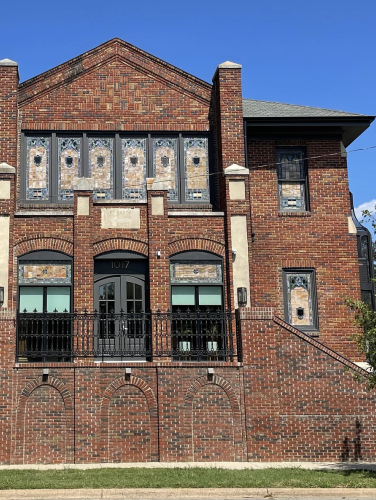
Parkwood Avenue ARP Church
(ca. 1929)
The Louis Asbury-designed Parkwood Avenue A.R.P. Church building reflects several social and residential shifts within twentieth-century Charlotte.
1017 Parkwood Ave., Charlotte, NC 28205
The Parkwood Avenue Associate Reformed Presbyterian Church building is generally regarded as the most architecturally noteworthy church in Charlotte’s Villa Heights community, one of several urban suburbs that arose in close proximity to downtown in the early 1900s. That period coincided with the significant growth of the Associate Reformed Presbyterian denomination in Charlotte, as evidenced by several other notable A.R.P church buildings constructed across the city at that time. Ultimately, the denomination was unable to sustain that initial success. Due to declining membership, at least five prominent Charlotte A.R.P. churches founded in the early twentieth century folded well before the end of the century, including Parkwood Avenue A.R.P.
Property Quick Links
The Parkwood Avenue congregation began as a Sabbath School in 1907 and was organized as the Villa Heights Associate Reformed Presbyterian Church in 1908. Soon thereafter, the congregation purchased the land comprising the present church location and a frame sanctuary was constructed from materials salvaged from the dismantled Sardis A.R.P. Church building. That first building was nearly destroyed by an August 1911 windstorm that swept through the neighborhood. A second wooden church rapidly reconstructed on the same land served as the congregation’s house of worship until 1928, when the congregation selected Charlotte native Louis Humbert Asbury, Sr., one of the region’s foremost building designers of the early twentieth century, to design the new church. After meeting in a nearby school during that construction, the congregation held its first worship service in its new home on January 20, 1929, and adopted the new name Parkwood Avenue A.R.P. Church.
Asbury (1877-1975), North Carolina’s first native-born professionally trained architect to practice in his home state, studied architecture at Trinity College (now Duke University) and M.I.T. before returning to his home town in 1908 to open his own firm. As North Carolina’s first member of the American Institute of Architects, Asbury earned hundreds of commissions, including such notable works as the First National Bank skyscraper on South Tryon, the Mecklenburg County Courthouse, Mayfair Manor (now Dunhill Hotel), and the Myers Park and Hawthorne Lane Methodist Churches.
In 1967, declining membership forced the Parkwood Avenue A.R.P. congregation to merge with Plaza Hills A. R. P. Church to form New Covenant A.R.P. Church. The Parkwood Avenue building was sold in 1968 to the Parkwood Institutional Christian Methodist Episcopal Church, part of the historically African American Methodist Episcopal denomination. That transfer of ownership reflected the changing racial population of Villa Heights and other inner suburbs across Charlotte and the South as increasing numbers of White residents moved farther from city centers and inner-city urban renewal campaigns forced African American residents into those abandoned inner suburbs. Following the 2015 relocation of the Parkwood Methodist Episcopal congregation, an adaptive reuse saw the transformation of the Parkwood Avenue building into residential apartments.

